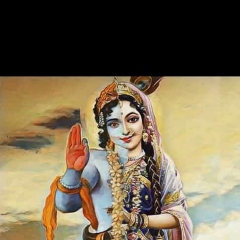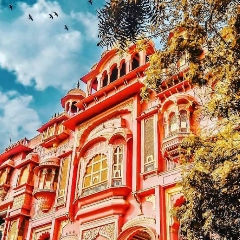Question 2 :
Represent the following situation in the form of a quadratic equation : The area of a rectangular plof is 528 $m^2$. The length of the plof (in metres) is one more than twice its breadth. We need to find the length and breadth of the plof.
Question 3 :
State True or False: If the coefficient of $x^2$ and the constant term of a quadratic equation have opposite signs, then the quadratic equation has real roots.
Question 4 :
The product of Sunita’s age (in years) two years ago and her age four years from now is one more than twice her present age. What is her present age?
Question 5 :
Find the roots of the following quadratic equation (by the factorisation method): $\frac{2}{5}x^2-x-\frac{3}{5}=0$
Question 6 :
John and Jivanti together have 45 marbles. Both of them lost 5 marbles each, and the product of the number of marbles they now have is 124. Find out how many marbles they had to start with.
Question 7 :
Find the roots of the following quadratic equation (by the factorisation method): $21x^2-2x+\frac{1}{21}=0$
Question 9 :
Using method of completing the square , $x^2+4x$ can be written as ?
Question 10 :
Find the roots of the following quadratic equation (by the factorisation method): $3\sqrt{2}x^2-5x-\sqrt{2}=0$
Question 11 :
Is it possible to design a rectangular park of perimeter 80 m and area $400 m^2$ ? If so, find its length and breadth.
Question 12 :
A train travels at a certain average speed for a distance of 63 km and then travels a distance of 72 km at an average speed of 6 km/h more than its original speed. If it takes 3 hours to complete the total journey, original average speed of the train is?
Question 13 :
A quadratic equation $ax^2 + bx + c =0$ has no real roots when :
Question 14 :
Values of $k$ for which the quadratic equation $2x^2–kx+k=0$ has equal roots is
Question 15 :
Find the roots of the equation $2x^2 – 5x + 3 = 0$, by factorisation.
Question 17 :
A quadratic equation $ax^2 + bx + c =0$ has two distinct real roots when :
Question 18 :
Find the roots of the following quadratic equation by factorisation: $2x^2 – x + \frac{1}{8} = 0$
Question 19 :
What are the roots of the quadratic equation $2x^2-\sqrt{5}x-2=0$ using the quadratic formula.
Question 20 :
A cottage industry produces a certain number of pottery articles in a day. It was observed on a particular day that the cost of production of each article (in rupees) was 3 more than twice the number of articles produced on that day. If the total cost of production on that day was Rs. 90, find the cost of each article?
Question 21 :
A natural number, when increased by 12, equals 160 times its reciprocal. The number is ____
Question 23 :
Check whether the following is quadratic equation : $x^3 - 4x^2 - x + 1 = (x-2)^3$
Question 24 :
Justify why the following quadratic equation has no two distinct real roots: $x\left(1-x\right)-2=0$
Question 25 :
Check whether the following is a quadratic equation: $(x + 1)^2 = 2(x – 3)$
Question 26 :
State True or False: Every quadratic equation has at least one real root.
Question 27 :
Find the roots of the quadratic equations, if they exist, by applying quadratic formula: $2x^2 + x – 4 = 0$
Question 29 :
State True or False whether the following quadratic equation has two distinct real roots: $x\left(1-x\right)-2=0$
Question 30 :
Which constant should be added and subtracted to solve the quadratic equation $4x^2-\sqrt{3}x-5=0$ by the method of completing the square?
Question 31 :
A cottage industry produces a certain number of pottery articles in a day. It was observed on a particular day that the cost of production of each article (in rupees) was 3 more than twice the number of articles produced on that day. If the total cost of production on that day was Rs. 90, find the number of articles produced.
Question 33 :
Is it possible to design a rectangular mango grove whose length is twice its breadth,and the area is $800 m^2$ ? If so, find its length and breadth.
Question 34 :
Check whether the following is quadratic equation : $x^2 + 3x + 1 = (x-2)^2$
Question 35 :
An express train takes 1 hour less than a passenger train to travel 132 km between Mysore and Bangalore (without taking into consideration the time they stop at intermediate stations). If the average speed of the express train is 11km/h more than that of the passenger train, find the average speed of the passenger train.
Question 36 :
Find the nature of the roots of the equation $3x^2 – 2x +\frac{1}{3} = 0$.
Question 37 :
State True or False whether the following quadratic equation has two distinct real roots: $2x^2+x-1=0$
Question 38 :
Justify why the following quadratic equation has two distinct real roots: $\left(x+1\right)\left(x-2\right)+x=0$
Question 39 :
An express train takes 1 hour less than a passenger train to travel 132 km between Mysore and Bangalore (without taking into consideration the time they stop at intermediate stations). If the average speed of the express train is 11km/h more than that of the passenger train, find the average speed of the express train.
Question 40 :
Does the following equation has the sum of its roots as 3? $-x^2+3x-3=0$













































